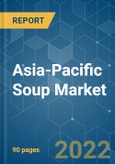Asia-Pacific Soup Market is projected to grow at a CAGR of 6.1% during the forecast period, 2020 - 2025.
Key Highlights
- The rising disposable income coupled with an increase in demand for convenience foods drives the growth of this market. Western influence on countries like India and the increasing awareness of the health benefits of soup in countries like Australia and Japan support the market
- The instant soup segment is the fastest growing in India and the dried soup segment dominates the market. Stable growth is expected in developed markets of Australia and Japan.
Key Market Trends
Increasing Demand for Convenience Foods
With the changing lifestyles, the demand for convenience foods is expected to increase at a faster rate during the forecast period, compared to the past five years in the region. There is a growing demand for convenience products, particularly among middle-to-higher-income consumers, who are in a position to pay more. The convenience of soups, which are healthier and tastier food alternatives, support the fast-paced lifestyle of these consumers. Factors, such as high availability, lesser cooking time, travel friendly, and good shelf life is added advantages in the soup market.
China Dominates the Soup Market in the Region
There is an increased consumption of soup in the region, as the soup is perceived to be both convenient and healthy. Hence, the soup market in China is expected to benefit from this trend during the forecast period. The growth of the soup market in China is expected to be further supported by an expansion of the ready-to-eat food market during the forecast period. Manufacturers employ various methods to increase their shares in the Chinese soup market. Some of these methods include distributing innovative products, enhancing their presence in new markets or regions, strengthening the base in the already existing markets, etc.
Competitive Landscape
The market for soups in Asia-Pacific is highly fragmented with a large number of international and regional vendors. The demand for exotic and natural flavors is very high in Asian countries and manufacturers are introducing new flavors. Also, in countries like India, the major companies are launching promotional campaigns to increase the awareness of the health benefits of soup. Some of the major players in the market include Bambino, Campbell Soup, ConAgra Foods, Nestlé, Unilever, Nissin Foods, among others.
Additional Benefits:
- The market estimate (ME) sheet in Excel format
- 3 months of analyst support
This product will be delivered within 2 business days.
Table of Contents
Methodology

LOADING...








